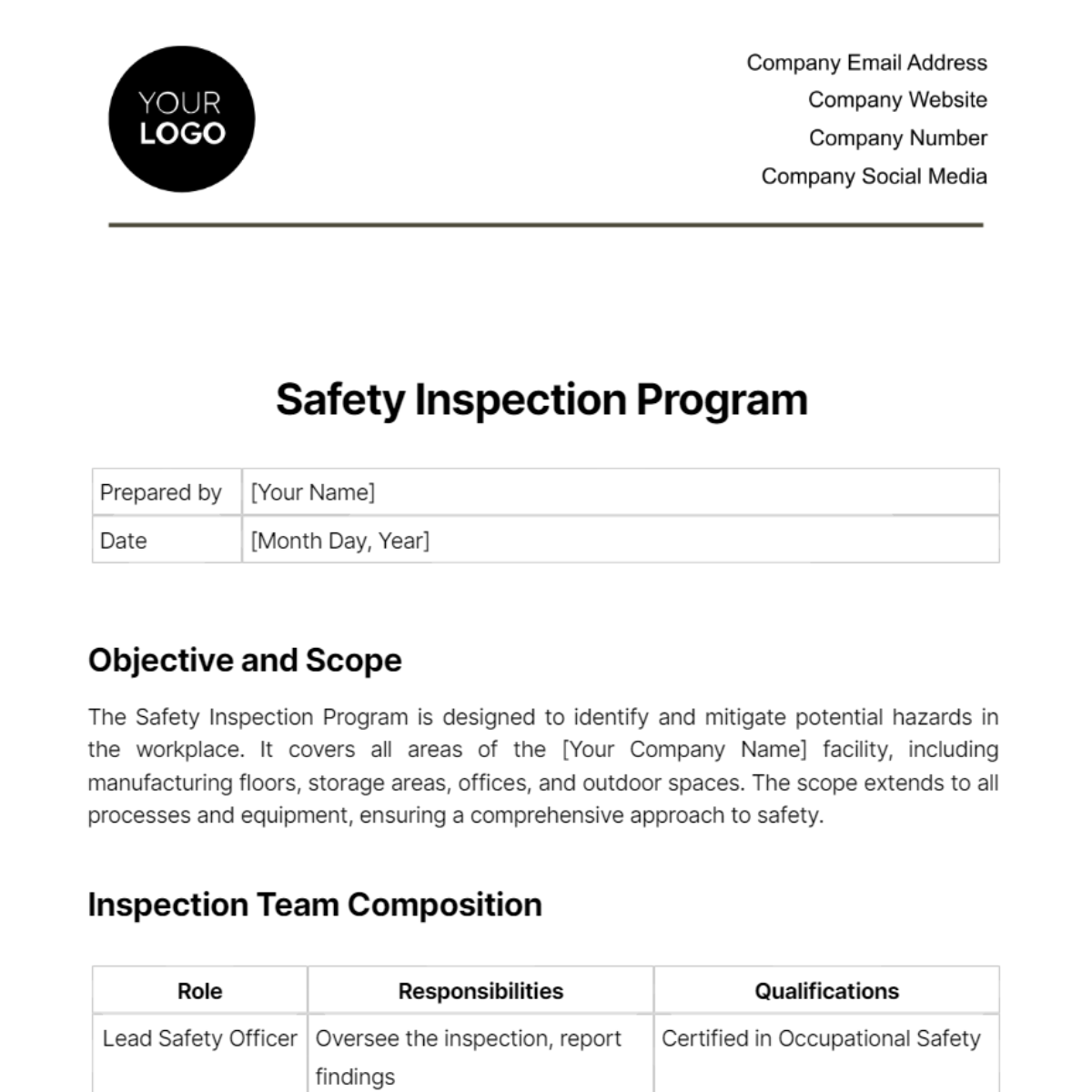Free Safety Inspection Program

Prepared by | [Your Name] |
Date | [Month Day, Year] |
Objective and Scope
The Safety Inspection Program is designed to identify and mitigate potential hazards in the workplace. It covers all areas of the [Your Company Name] facility, including manufacturing floors, storage areas, offices, and outdoor spaces. The scope extends to all processes and equipment, ensuring a comprehensive approach to safety.
Inspection Team Composition
Role | Responsibilities | Qualifications |
Lead Safety Officer | Oversee the inspection, report findings | Certified in Occupational Safety |
Engineer | Inspect machinery, structural integrity | Degree in Engineering |
Fire Safety Expert | Check fire safety equipment and protocols | Trained in Fire Safety Management |
HR Representative | Ensure employee safety concerns are heard | Experienced in HR Policies |
Frequency and Timing of Inspections
Inspections are scheduled quarterly, with additional inspections after significant changes (e.g., new machinery installations). High-risk areas such as the [chemical processing unit] will undergo monthly inspections.
Inspection Checklist Development
Each area has a tailored checklist. For example, the manufacturing floor checklist includes items such as machine guards, spillage control, and emergency stop mechanisms.
Inspection Procedures
Inspections follow a step-by-step process, starting with a team briefing and ending with a debrief. During the inspection, team members use [digital tablets] for real-time data entry. Immediate hazards are reported directly to the [emergency response team].
Training and Communication
All team members undergo annual training in safety inspection procedures. The inspection schedule is communicated to employees via [the internal web portal and email].
Data Analysis and Reporting
Inspection data is analyzed using [SafeInsight software], identifying trends and recurring issues. Reports are generated in a standardized format and presented at [quarterly safety meetings].
Corrective Action Plan
A corrective action plan is developed for each identified hazard, with specific timelines and assigned responsibilities. For example, a faulty conveyor belt identified in the inspection must be repaired within 48 hours.
Follow-up and Continuous Improvement
Follow-up inspections ensure the effectiveness of corrective actions. The program undergoes an annual review for improvements, incorporating feedback from employees and inspection teams.
Documentation and Record Keeping
All inspections are documented and stored in the [SafeRecords system] for a minimum of five years, ensuring compliance with [industry regulations and standards].
Audit and Review of Inspection Program
An annual audit of the inspection program is conducted by [an external safety consultancy firm], ensuring objectivity and adherence to best practices.
Additional Considerations:
Regulatory Compliance: The program aligns with [XYZ National Safety Regulations] and local laws.
Employee Involvement: Employees are encouraged to report potential hazards through [an anonymous reporting system].
Technology Utilization: The program integrates cutting-edge technologies like [drone inspections] for hard-to-reach areas.
By integrating these comprehensive steps and procedures, [Your Company Name] aims to maintain a safe and healthy working environment for all its employees. Regular updates to the program ensure alignment with evolving safety standards and technological advancements.
- 100% Customizable, free editor
- Access 1 Million+ Templates, photo’s & graphics
- Download or share as a template
- Click and replace photos, graphics, text, backgrounds
- Resize, crop, AI write & more
- Access advanced editor
Introducing Template.net's Safety Inspection Program Template, a comprehensive tool for conducting safety inspections. Fully customizable and editable with our Ai Editor Tool, this template empowers businesses to tailor inspection programs to their specific needs. Streamline safety protocols and ensure compliance effortlessly with our user-friendly platform. Simplify safety inspections and enhance workplace safety with this versatile template solution.





























